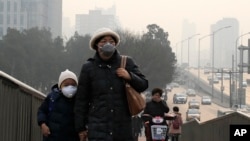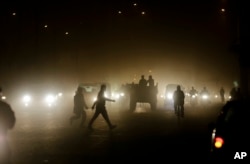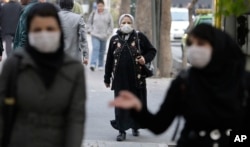Heavy smog on Tuesday shrouded the capitals of the world’s two most populous countries. Air quality monitoring stations in Beijing and New Delhi displayed readings far exceeding the threshold for the highest-category hazardous level.
The Chinese capital on Monday and Tuesday was under its second-ever pollution red alert prompting Beijing's metropolitan government to order factories to reduce production or shut down, pull half the vehicles off the capital's roads and close schools.
The city's first red alert was issued on December 7.
In the early afternoon on Tuesday, air quality index machines in central Beijing showed readings in excess of 400 micrograms per cubic meter for PM2.5 (particles less than 2.5 micrometers in diameter, which can lodge in the lungs).
The issuing of red alerts, however, does not mean Beijing's air is actually more polluted than it has been in the past.
“The reason that the municipal government decided to issue the red alert is to justify more radical measures to control the pollution level,” said Yanzhong Huang, senior fellow for global health at the Council on Foreign Relations. “It turns out indeed that limiting the number of cars on the road actually brought down the level of pollution.”
In India's capital, after a respite about a decade ago when anti-pollution measures led to improvements, the city is again choking on air considered the worst in the world, according to the World Health Organization (WHO).
“Studies have shown that in Delhi every third child has impaired lungs now. If you look at the number of premature deaths that get reported from different studies in this city that virtually works out to be one death per hour due to air pollution related diseases,” said Anumita Roychowdhury, executive director for research and advocacy at the Center for Science and Environment in New Delhi.
The World Bank this year calculated that the shortened lifespans of people in India’s cities due to air pollution is costing the country’s economy $18 billion annually.
“Right now during winter it's so visible. You can sense, you can smell that smog,” Roychowdhury told VOA on Tuesday.
Little to show for vehicle bans, litigation
India's Supreme Court has banned through the end of March, registrations of large diesel luxury cars. The New Delhi government has ordered odd and even numbered vehicles to use roads on alternate days during the first half of January.
The Delhi High Court, which previously said that living in the Indian capital was akin to being in a “gas chamber,” on Monday declared an emergency. Two judges of the court directed all concerned authorities to follow existing rules, chastised traffic police for being ineffective in reducing road congestion and ordered officials to ensure particulate matter levels not exceed 60 microgram per cubic meter per day for the particularly lethal PM2.5 and 100 microgram per cubic meter per day for PM10.
The WHO considers any level above 25 micrograms as unsafe.
The U.S. Embassy in New Delhi late Tuesday morning recorded the air quality index at a hazardous 534.
The judicial intervention in India comes after public interest litigation initiated as far back as 20 years ago.
“The reason why the courts get involved is when the civil society is angry about an issue and they use the public interest litigation instrument to go to the court to seek relief,” explained Roychowdhury. “In response to that public interest litigation the courts respond. So it is not that the judges just suddenly intervene on their own.”
The central government's transport minister, Nitin Gadkari, has vowed to cut Delhi's pollution by building a ring road so trucks will not have to drive through the capital. He also wants more vehicles to use ethanol fuel. But the minister acknowledges this will not solve the bad air problem in Delhi because burning farm waste and construction dust also contribute.
Problems in Dhaka, Tehran
In Dhaka, the world's fastest growing mega-city where at least 15 million people are residing, traffic congestion and smoke from brick kilns create pollution blamed for killing thousands of residents every year and causing between 80 million and 230 million cases annually of respiratory diseases, according to the Bangladesh Ministry of Environment and Forests.
“During the winter it’s dry and there’s a lot of construction,” thus the air pollution is worse, said associate professor of chemistry Mominul Islam who answered the phone Tuesday at the University of Dhaka’s air quality research and monitoring center.
The center, as well as the Bangladesh Ministry of Environment, however, have no equipment to record PM2.5 readings, according to the professor, thus there is no way to gauge whether Dhaka’s air is currently worse than Beijing’s or Delhi’s.
“We hope to have equipment online from February,” he said.
A high pollution alert also prompted Iranian authorities in Tehran, Isfahan and Arak, to close all schools for two days from Sunday. It was the first such order since 2010.
The PM2.5 levels recorded Sunday and Monday in Tehran were in the unhealthy range, but far superior to those of Beijing and New Delhi.
Canned air for sale
Across the region authorities are still grappling with how to combat the pollution in the long run.
“Even in the case of China where we've seen the top leaders themselves increasingly committed to pollution control there's no consensus on how to effectively address the problem,” Huang, a professor at Seton Hall University who just returned from Beijing, told VOA. “And, of course, in Delhi, India you face similar challenges on how to handle the dilemma between economic development and environmental pollution.”
Well-heeled Chinese are purchasing high-quality imported air purifiers for their homes and offices. But those units are too expensive for many Chinese who have resorted to rigging up makeshift units by attaching glass-fiber filters to household fans.
A Canadian company, Vitality Air, which began bottling Rocky Mountain air as a joke, now claims to have sold thousands of cans in China for up to $28 each.










